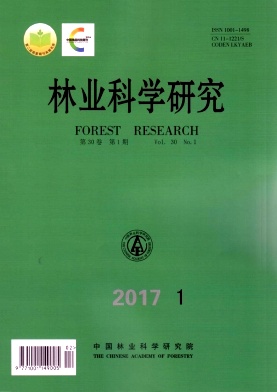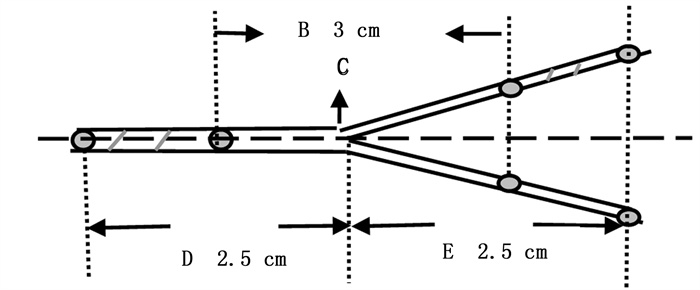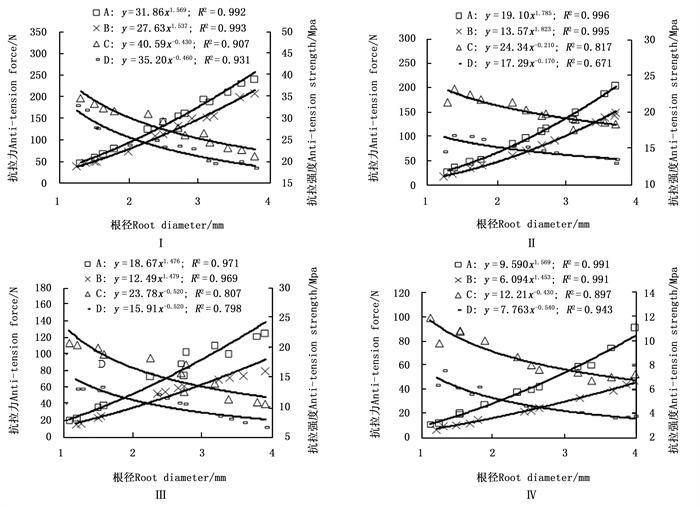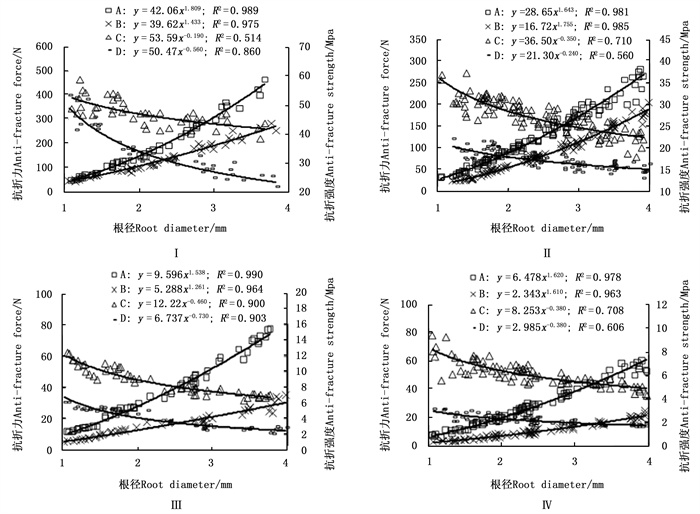-
近几年, 植物根系的形态分布与土壤的相互作用以及根系固土力学机理成为研究热点 [1-7]。植物根群由直根和侧根分支组成, 而直根和侧根分支处内部结构及次生生长等存在较大差异, 有可能影响二者对外营力的抵抗能力。根系在土体中交错分布, 加之土体坍塌错动的复杂性, 使得各条根的轴线与剪切面呈不同角度, 当根-土复合体发生位移时, 根可能承受轴向拉力, 也可能承受径向折力。轴向拉力是指根系沿根轴线方向上所受的轴向作用力。目前, 根系抗拉特性的研究已有不少报道[8-14]。径向折力是指两端固定在土壤中的根系受到的垂直于根轴线的径向作用力。现阶段大多数学者采用悬臂梁、三点弯曲、四点弯曲等只固定根系一端的方法, 对根系的抗弯(抗折)、茎的抗倒伏特性进行研究, 而对于两端都被固定的根系在受到垂直于根轴线的径向作用力时的抗折特性仅有本课题组进行了研究报道[15-16]。抗折特性的研究可以充实植物根系固土力学机制, 为植物固土护坡机理提供一定的理论基础。作为根群的主要组成——侧根分支处和相邻直根在轴向拉力和径向折断力作用下的薄弱处及其相应的力学参数, 即根系易损部位的研究, 对于更全面地揭示根系固土的力学机制具有重要意义; 然而, 上述问题目前尚未报道。本文以3~4年生柠条(Caragana korshinskii Kom.)、沙柳(Salix psammophila C. Wang et Chang Y. Yang)、沙棘(Hippophae rhamnoides Linn.)、白沙蒿(Artemisia sphaerocephala Krasch.) 单根为研究对象, 研究其1~4 mm径级范围内的侧根分支处和相邻直根抗拉特性的差异和抗折特性的差异, 探讨4种植物根系的易损部位, 以期为根系固土力学机制的深入研究提供理论依据。
HTML
-
试验根系取自位于内蒙古自治区巴彦淖尔市磴口县的柠条、沙柳、沙棘、白沙蒿样地。在植物生长旺盛期8月, 随机抽取每种植物20株, 测量每株植物的地径、冠幅、株高, 取各指标的平均值作为衡量该植物标准株的指标。选取4种植物的标准株在其一侧由外逐渐向内挖掘并采集试验所需的根系。将采集好的根系用湿沙土覆盖, 并置于4℃(与0~20 cm土壤深度的平均地温接近)作用的环境中, 带回试验室尽快完成试验。
-
4种植物均选取根径为1~4 mm的侧根分支处及与它相邻的上级直根段, 侧根分支处与它相连的上级直根段的根径在同一根径范围内。以0.5 mm为一个径级单位分别对侧根分支处和相邻直根进行分组, 每一径级组选取20根左右进行试验。
图 1所示: 直根总长为5 cm, 其中, 阴影部分为夹具夹持部位, 两夹具间即受力段为3 cm, 夹具两端各1 cm。从直根中点向两端每隔5 mm做一标记点并测量该标记点的直径。标记点每隔180°测量一次, 取平均值作为该直根的平均直径。
图 2所示: 以侧根分支处为中点, 沿上级直根段的轴向总长同为5 cm, 其中, 阴影部分为夹具夹持部位, 两夹具间距离3 cm, 夹具两端各1 cm。由于侧根分支处根径横截面不一定呈规则圆形, 因此, 对其每隔120°测量1次直径, 取3次直径平均值作为侧根分支处直径。
-
抗折试验根的选取与制备方法同抗拉试验, 其中, 带有侧根分支处的试验根与相邻直根段总长均8 cm, 2种根受力段均为4 cm, 夹具两端各2 cm。从试验根的中点(侧根分支段的中点为侧根分支处)向两端每隔1 cm做标记并测量标记点的直径, 标记点的测量方法同抗拉试验。
-
抗拉力和抗折力均由TY8000伺服控制材料试验机进行测定, 加载速度均为500 mm·min-1。抗拉力测定时将试验根的上下两端分别垂直固定在试验机的上下夹具内, 其中, 侧根分支处根段的上级根固定在试验机的上夹具内, 2根下级根分别用3点固定式夹具夹持并调整夹具的角度以确保每一下级根轴向受力, 启动试验机, 对根系施加轴向拉力, 直至根被拉断。抗折试验使直根呈水平状态, 用自制夹具将直根两端固定, 施力点位于直根受力段中点的上方(图 1), 带有侧根分支处的试验根使侧根分支处位于受力段的中点, 用自制夹具水平固定侧根分支段的上级根和两根下级根, 在侧根分支处施加垂直于根轴线的点压力(图 2)。极限抗拉力和抗折力由电脑自动记录。本试验中抗折强度为破坏处单位根横截面积上的抗折力。
抗拉强度、抗折强度计算公式:
式中: P—抗拉强度、抗折强度(MPa); F—抗拉力、抗折力(N); D—断裂处直径(mm)。
-
采用Excel 2007和SAS 9.0软件处理数据。
1.1. 试验材料采集
1.2. 试验根的选取与制备
1.2.1. 抗拉试验根的选取与制备
1.2.2. 抗折试验根的选取与制备
1.3. 抗拉力和抗折力的测定
1.4. 数据处理
-
对参试的4种植物, 每种植物侧根分支处与相邻直根的抗拉力之间, 侧根分支处与相邻直根的抗拉强度之间均存在显著差异(P < 0.05)。图 3表明: 在1~4 mm根径范围内, 4种植物侧根分支处和相邻直根的抗拉力均与直径呈幂函数正相关, 抗拉强度与直径呈幂函数负相关。同一径级下, 4种植物侧根分支处的抗拉力均小于相邻直根的抗拉力, 且随着根径的增大, 侧根分支处与相邻直根的抗拉力差值增大。根径为1.5 mm时, 柠条、沙柳、沙棘、白沙蒿侧根分支处与相邻直根的抗拉力差值分别为: -8.67、-10.98、-11.22、-7.14 N; 根径为3.5 mm时, 4种植物侧根分支处与相邻直根的抗拉力差值分别为: -38.01、-45.60、-39.05、-30.87 N。4种植物根的抗拉强度也是侧根分支处小于相邻直根, 其中4种植物的代表根根径1.5 mm时[17-18], 侧根分支处和相邻直根的抗拉强度比值为柠条85.6%, 沙柳72.1%, 沙棘67.0%, 白沙蒿60.6%。
-
4种植物侧根分支处与相邻直根的抗折力间以及侧根分支处和相邻直根的抗折强度间均存在显著性差异(P < 0.05)。由图 4可以看出: 在1~4 mm径级范围内, 4种植物侧根分支处和相邻直根的抗折力均与直径呈幂函数正相关, 抗折强度与直径呈幂函数负相关。4种植物同一径级根的抗折力均为侧根分支处小于相邻直根。柠条侧根分支处直径从1.06 mm增至3.83 mm, 抗折力变化为(60.65±10.10)~(268.17±15.76) N, 相邻直根直径从1.10 mm增至3.68 mm, 抗折力变化为(63.94±10.20)~(429.57±34.83) N; 沙柳侧根分支处直径从1.21 mm增至3.98 mm, 抗折力变化为(28.30±2.36)~(177.09±13.89) N, 相邻直根直径从1.04 mm增至3.92 mm, 抗折力变化为(42.41±7.73)~(244.66±28.04) N; 沙棘侧根分支处直径从1.02 mm增至3.97 mm, 抗折力变化为(6.81±1.34)~(27.53±4.09) N, 相邻直根直径从1.07 mm增至3.76 mm, 抗折力变化为(12.99± 1.36)~(66.96±6.89) N; 白沙蒿侧根分支处直径从1.07 mm增至3.95 mm, 抗折力变化为(3.62±0.61)~(20.62±1.83) N, 相邻直根直径从1.05 mm增至3.87 mm, 抗折力变化为(9.14±1.90)~(54.83 ±3.09)N。4种植物侧根分支处的抗折强度亦小于同径级相邻直根的抗折强度。当根径为1.5 mm时, 柠条、沙柳、沙棘、白沙蒿侧根分支处的抗折强度分别是相邻直根的80.9%, 61.1%, 49.3%, 36.0%。
2.1. 4种植物侧根分支处和相邻直根抗拉特性的差异
2.2. 4种植物侧根分支处和相邻直根抗折特性的差异
-
不少学者对根系固土的效应和机制进行了研究, 并建立了相应的模型, 其中, 被广泛应用的有Wu和Waldr-on建立的垂直根模型(WWM)和Pollen和Simon建立的纤维束模型(FBM) [19-22]。有研究表明: 垂直根模型和纤维束模型对植物根系固土能力的预测值比实测值偏高[11-23-25]。针对模型预测值偏高的现有解释为: 垂直根模型和纤维束模型假设根的表面受到足够的摩阻力、约束力且有足够的锚固长度使根系不被拉出, 而实际部分根会在未达到极限抗拉强度时, 即在拉断前被拔出, 这是垂直根模型和纤维束模型高估根系固土效果的原因之一。另外, 垂直根模型假定当根土复合体发生剪切时, 穿过剪切面的所有根在同一时刻全部达到抗拉强度, 根系同时被拉断, 实际根系在剪切过程中是逐根断裂的。这是造成垂直根模型预测值偏高的第2个原因。本文认为, 除上述原因外, 以下2点也是造成模型预测值偏高的主要原因。第一, 垂直根模型和纤维束模型假设穿过土体剪切面的根为外形理想的轴向受拉的圆柱体, 即模型只考虑了直根, 忽略了侧根分支处。实际根系网由侧根分支处和直根共同组成。侧根分支处和直根共同穿过土壤并相互交织成网状, 与土壤紧密结合形成根土复合体。本文研究结果表明, 4种植物侧根分支处的抗拉强度和抗折强度均小于直根, 即侧根分支处是根系固土的薄弱部位, 忽视侧根分支处抵抗外营力的能力不及直根的事实, 必然造成对根土复合体固土能力的高估。第二, 垂直根模型和纤维束模型假设根土复合体中的所有根系与剪切面垂直, 根系为沿根长方向受拉力的杆件。实际根系在土体中交错分布, 加之土体坍塌错动的复杂性, 使得根与剪切面呈不同角度, 根-土复合体发生剪切时, 根可能承受沿根轴线的轴向拉力作用, 两端被固持在土体中的根系也可能承受垂直根轴线的径向折力作用。本文分析结果显示: 根系抗拉强度与抗折强度的差异因植物种不同而异。同一径级下, 柠条和沙柳直根和侧根分支处的抗折强度大于抗拉强度, 沙棘和白沙蒿反之。1~4 mm径级内, 柠条、沙柳、沙棘、白沙蒿侧根分支处的抗拉强度分别为抗折强度的75.1%、85.6%、274.3%、232.3%;4种植物直根的抗拉强度分别为抗折强度的63.2%、74.3%、186.2%、142.6%。对于抗折强度小于抗拉强度的植物, 如沙棘和白沙蒿, 受径向折力作用的根在未达到极限抗拉力时已经达到极限抗折力而断裂。这会导致模型高估抗折强度小于抗拉强度植物根的实际固土能力。
-
在1~4 mm径级内, 4种植物侧根分支处和相邻直根的抗拉力、抗折力均与直径呈幂函数正相关, 抗拉强度、抗折强度均与直径呈幂函数负相关。同径级下, 每种植物单根的抗拉力和抗折力均为侧根分支处小于相邻直根, 抗拉强度和抗折强度也如此。根径为1.5 mm时, 柠条、沙柳、沙棘、白沙蒿侧根分支处与相邻直根的抗拉力差值分别为: -8.67、-10.98、-11.22、-7.14 N; 4种植物侧根分支处与相邻直根的抗折力差值分别为: -16.75、-21.74、-9.09、-7.99 N。侧根分支处和相邻直根的抗拉强度为柠条((23.70±3.97)、(28.02±4.40) MPa) > 沙柳((14.86±1.28)、(20.33±1.76) MPa) > 沙棘((10.60±2.40)、(15.86±3.90) MPa) > 白沙蒿((5.07±1.25)、(8.80±1.74) MPa); 侧根分支处和相邻直根的抗折强度为: 柠条((33.66±7.74)、(47.06±4.41) MPa) > 沙柳((17.31±1.91)、(27.54±3.82) MPa) > 沙棘((3.97±1.23)、(8.75±1.70) MPa) > 白沙蒿((2.18±0.39)、(6.15±1.01) MPa)。4种植物单根在轴向拉力和径向折力作用下, 侧根分支处都为易损部位。
造成垂直根模型(WWM)和纤维束模型(FBM)预测值偏高的原因应补充两点: ①模型根系全部计入直根的抗拉力, 忽略了侧根分支处, 而侧根分支处是根系固土的薄弱点。②模型假设根土复合体发生剪切时, 所有根系只在轴向方向受拉, 而实际在土体被剪切时, 根可能承受轴向拉力, 也可能承受径向折力。不同植物种, 单根抵抗拉力和折力的特性不同, 对于单根抗折强度小于抗拉强度的植物, 模型必然高估根系的实际固土能力。










 DownLoad:
DownLoad:


